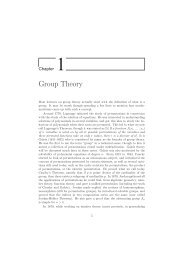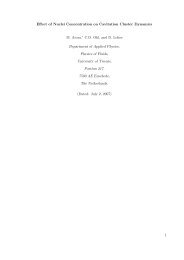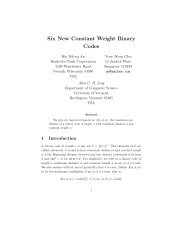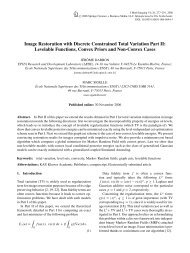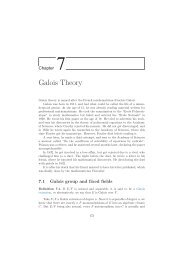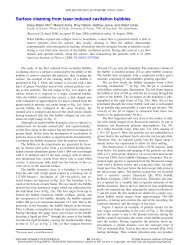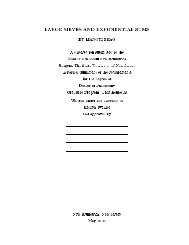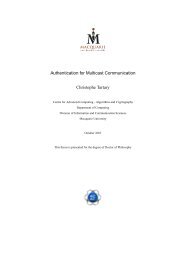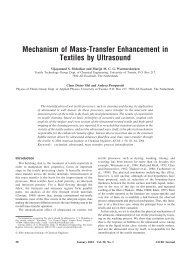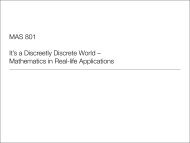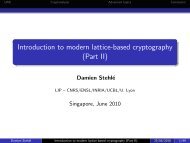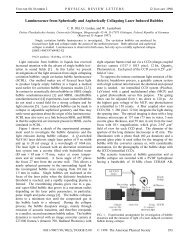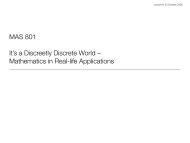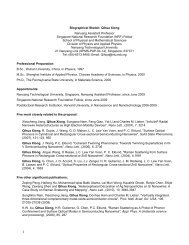Iterated Space-Time Code Constructions from Quaternion Algebras
Iterated Space-Time Code Constructions from Quaternion Algebras
Iterated Space-Time Code Constructions from Quaternion Algebras
You also want an ePaper? Increase the reach of your titles
YUMPU automatically turns print PDFs into web optimized ePapers that Google loves.
Outline<br />
MIMO Channel<br />
<strong>Code</strong>s <strong>from</strong> <strong>Algebras</strong><br />
Decoding<br />
Fast Decodability<br />
<strong>Iterated</strong> Construction<br />
<strong>Iterated</strong> <strong>Space</strong>-<strong>Time</strong> <strong>Code</strong> <strong>Constructions</strong> <strong>from</strong> <strong>Quaternion</strong><br />
<strong>Algebras</strong><br />
Nadya Markin, Frédérique Oggier<br />
School of Physical and Mathematical Sciences, Nanyang Technological University<br />
August 26, 2011<br />
Nadya Markin, Frédérique Oggier <strong>Iterated</strong> <strong>Space</strong>-<strong>Time</strong> <strong>Code</strong> <strong>Constructions</strong> <strong>from</strong> <strong>Quaternion</strong> <strong>Algebras</strong>
Talk Outline<br />
1 MIMO Channel<br />
MIDO codes<br />
2 <strong>Code</strong>s <strong>from</strong> <strong>Algebras</strong><br />
3 Decoding<br />
4 Fast Decodability<br />
Outline<br />
MIMO Channel<br />
<strong>Code</strong>s <strong>from</strong> <strong>Algebras</strong><br />
Decoding<br />
Fast Decodability<br />
<strong>Iterated</strong> Construction<br />
5 <strong>Iterated</strong> Construction<br />
Diversity Criteria<br />
Examples of <strong>Iterated</strong> MIDO <strong>Code</strong>s<br />
Performance of <strong>Iterated</strong> MIDO <strong>Code</strong>s<br />
Nadya Markin, Frédérique Oggier <strong>Iterated</strong> <strong>Space</strong>-<strong>Time</strong> <strong>Code</strong> <strong>Constructions</strong> <strong>from</strong> <strong>Quaternion</strong> <strong>Algebras</strong>
MIMO Channel<br />
Outline<br />
MIMO Channel<br />
<strong>Code</strong>s <strong>from</strong> <strong>Algebras</strong><br />
Decoding<br />
Fast Decodability<br />
<strong>Iterated</strong> Construction<br />
MIDO codes<br />
Multiple Input Multiple Output<br />
• <strong>Space</strong>-time codes: used in multiple-antennae systems for higher data rate and<br />
reliability over fading channels<br />
Nadya Markin, Frédérique Oggier <strong>Iterated</strong> <strong>Space</strong>-<strong>Time</strong> <strong>Code</strong> <strong>Constructions</strong> <strong>from</strong> <strong>Quaternion</strong> <strong>Algebras</strong>
System Model: MIDO codes<br />
Multiple Input Double Output<br />
Outline<br />
MIMO Channel<br />
<strong>Code</strong>s <strong>from</strong> <strong>Algebras</strong><br />
Decoding<br />
Fast Decodability<br />
<strong>Iterated</strong> Construction<br />
MIDO codes<br />
Application: Broadcasting to a portable device<br />
Consider: 4 Transmit, 2 Receive antannae R1, R2, perfect CSIR<br />
At each time interval j,<br />
R1 receives a superposition of signals<br />
(x1j , x2j , x3j , x4j ) plus noise<br />
Nadya Markin, Frédérique Oggier <strong>Iterated</strong> <strong>Space</strong>-<strong>Time</strong> <strong>Code</strong> <strong>Constructions</strong> <strong>from</strong> <strong>Quaternion</strong> <strong>Algebras</strong>
System Model: MIDO codes<br />
Multiple Input Double Output<br />
Outline<br />
MIMO Channel<br />
<strong>Code</strong>s <strong>from</strong> <strong>Algebras</strong><br />
Decoding<br />
Fast Decodability<br />
<strong>Iterated</strong> Construction<br />
MIDO codes<br />
Application: Broadcasting to a portable device<br />
Consider: 4 Transmit, 2 Receive antannae R1, R2, perfect CSIR<br />
At each time interval j,<br />
R1 receives a superposition of signals<br />
(x1j , x2j , x3j , x4j ) plus noise<br />
(h11x1j + . . . + h14x4j ) + n1j<br />
Nadya Markin, Frédérique Oggier <strong>Iterated</strong> <strong>Space</strong>-<strong>Time</strong> <strong>Code</strong> <strong>Constructions</strong> <strong>from</strong> <strong>Quaternion</strong> <strong>Algebras</strong>
System Model: MIDO codes<br />
Multiple Input Double Output<br />
Outline<br />
MIMO Channel<br />
<strong>Code</strong>s <strong>from</strong> <strong>Algebras</strong><br />
Decoding<br />
Fast Decodability<br />
<strong>Iterated</strong> Construction<br />
MIDO codes<br />
Application: Broadcasting to a portable device<br />
Consider: 4 Transmit, 2 Receive antannae R1, R2, perfect CSIR<br />
At each time interval j,<br />
R1 receives a superposition of signals<br />
(x1j , x2j , x3j , x4j ) plus noise<br />
R2 receives<br />
(h11x1j + . . . + h14x4j ) + n1j<br />
Nadya Markin, Frédérique Oggier <strong>Iterated</strong> <strong>Space</strong>-<strong>Time</strong> <strong>Code</strong> <strong>Constructions</strong> <strong>from</strong> <strong>Quaternion</strong> <strong>Algebras</strong>
System Model: MIDO codes<br />
Multiple Input Double Output<br />
Outline<br />
MIMO Channel<br />
<strong>Code</strong>s <strong>from</strong> <strong>Algebras</strong><br />
Decoding<br />
Fast Decodability<br />
<strong>Iterated</strong> Construction<br />
MIDO codes<br />
Application: Broadcasting to a portable device<br />
Consider: 4 Transmit, 2 Receive antannae R1, R2, perfect CSIR<br />
At each time interval j,<br />
R1 receives a superposition of signals<br />
(x1j , x2j , x3j , x4j ) plus noise<br />
R2 receives<br />
(h11x1j + . . . + h14x4j ) + n1j<br />
(h21x1j + . . . + h24x4j ) + n2j<br />
Nadya Markin, Frédérique Oggier <strong>Iterated</strong> <strong>Space</strong>-<strong>Time</strong> <strong>Code</strong> <strong>Constructions</strong> <strong>from</strong> <strong>Quaternion</strong> <strong>Algebras</strong>
System Model: MIDO codes<br />
Multiple Input Double Output<br />
Outline<br />
MIMO Channel<br />
<strong>Code</strong>s <strong>from</strong> <strong>Algebras</strong><br />
Decoding<br />
Fast Decodability<br />
<strong>Iterated</strong> Construction<br />
MIDO codes<br />
Application: Broadcasting to a portable device<br />
Consider: 4 Transmit, 2 Receive antannae R1, R2, perfect CSIR<br />
At each time interval j,<br />
R1 receives a superposition of signals<br />
(x1j , x2j , x3j , x4j ) plus noise<br />
R2 receives<br />
(h11x1j + . . . + h14x4j ) + n1j<br />
(h21x1j + . . . + h24x4j ) + n2j<br />
To transmit 8 complex symbols, need<br />
coherence time of at least 4.<br />
Putting this into matrix form we<br />
obtain:<br />
Y2×4 = H2×4X4×4 + N2×4<br />
H = channel matrix<br />
X = space-time codeword<br />
N = noise matrix<br />
H, N are i.i.d. complex Gaussian<br />
Nadya Markin, Frédérique Oggier <strong>Iterated</strong> <strong>Space</strong>-<strong>Time</strong> <strong>Code</strong> <strong>Constructions</strong> <strong>from</strong> <strong>Quaternion</strong> <strong>Algebras</strong>
Outline<br />
MIMO Channel<br />
<strong>Code</strong>s <strong>from</strong> <strong>Algebras</strong><br />
Decoding<br />
Fast Decodability<br />
<strong>Iterated</strong> Construction<br />
<strong>Algebras</strong>: a tool for STC<br />
Full Diversity: Want a collection of matrices so that<br />
min{det(X − Y ) : X , Y ∈ C } �= 0<br />
this bounds pairwise probability of error (Tarokh et al)<br />
<strong>Algebras</strong> give rise to space-time codes<br />
linearity<br />
full diversity (in case algebra is division)<br />
nice criteria for diversity<br />
Nadya Markin, Frédérique Oggier <strong>Iterated</strong> <strong>Space</strong>-<strong>Time</strong> <strong>Code</strong> <strong>Constructions</strong> <strong>from</strong> <strong>Quaternion</strong> <strong>Algebras</strong>
Outline<br />
MIMO Channel<br />
<strong>Code</strong>s <strong>from</strong> <strong>Algebras</strong><br />
Decoding<br />
Fast Decodability<br />
<strong>Iterated</strong> Construction<br />
<strong>Algebras</strong>: a tool for STC<br />
Full Diversity: Want a collection of matrices so that<br />
min{det(X − Y ) : X , Y ∈ C } �= 0<br />
this bounds pairwise probability of error (Tarokh et al)<br />
<strong>Algebras</strong> give rise to space-time codes<br />
linearity<br />
full diversity (in case algebra is division)<br />
nice criteria for diversity<br />
Many examples of codes with good performance already known.<br />
Problem: Maximum Likelihood (ML) decoding complexity too high<br />
Need algebraic codes which are fast decodable<br />
Nadya Markin, Frédérique Oggier <strong>Iterated</strong> <strong>Space</strong>-<strong>Time</strong> <strong>Code</strong> <strong>Constructions</strong> <strong>from</strong> <strong>Quaternion</strong> <strong>Algebras</strong>
ML Decoding<br />
Outline<br />
MIMO Channel<br />
<strong>Code</strong>s <strong>from</strong> <strong>Algebras</strong><br />
Decoding<br />
Fast Decodability<br />
<strong>Iterated</strong> Construction<br />
A 4 × 4 MIDO code can transmit up to 8 complex information symbols, so 16<br />
real (say PAM) information symbols.<br />
<strong>Space</strong>-time code C is a vector space generated by matrices Bi .<br />
In our case Bi ∈ Mat4×4 and X ∈ C has the form<br />
X =<br />
16X<br />
gi Bi ,<br />
where gi are the information symbols <strong>from</strong> a real constellation.<br />
ML Decoding<br />
Y = received matrix. Minimize the distance<br />
i=1<br />
{d(X ) = ||Y − HX || 2 F }X ∈C<br />
Nadya Markin, Frédérique Oggier <strong>Iterated</strong> <strong>Space</strong>-<strong>Time</strong> <strong>Code</strong> <strong>Constructions</strong> <strong>from</strong> <strong>Quaternion</strong> <strong>Algebras</strong><br />
(1)
QR Decomposition<br />
Outline<br />
MIMO Channel<br />
<strong>Code</strong>s <strong>from</strong> <strong>Algebras</strong><br />
Decoding<br />
Fast Decodability<br />
<strong>Iterated</strong> Construction<br />
Each 4x4 matrix Bi ↦→ HBi ↦→ bi ∈ R 16 ∼ = C 8<br />
A 16-dimensional code gives rise the the matrix<br />
QR decomposition: B = QR, with Q † Q = I ,<br />
ML decoding<br />
reduces to minimizing<br />
B = (b1, b2, . . . , b16) ∈ M16×16(R), (2)<br />
d(X ) = ||y − QRg|| 2 E = ||Q† y − Rg|| 2 E<br />
Complexity of exhaustive search is O(|S| 16 ), where S = the constellation.<br />
Fast decodable codes: those which offer improvement on decoding complexity.<br />
Nadya Markin, Frédérique Oggier <strong>Iterated</strong> <strong>Space</strong>-<strong>Time</strong> <strong>Code</strong> <strong>Constructions</strong> <strong>from</strong> <strong>Quaternion</strong> <strong>Algebras</strong><br />
(3)
Fast Decodability<br />
Outline<br />
MIMO Channel<br />
<strong>Code</strong>s <strong>from</strong> <strong>Algebras</strong><br />
Decoding<br />
Fast Decodability<br />
<strong>Iterated</strong> Construction<br />
Complexity can be reduced if R is guaranteed to have a nice zero-structure.<br />
Definition (Fast-decodable <strong>Code</strong>s)<br />
A space-time code is said to be fast-decodable if its R matrix has the following form:<br />
» –<br />
∆ B1<br />
R = ,<br />
0 R2<br />
where ∆ is a diagonal matrix and R2 is upper-triangular.<br />
Definition (g-group Decodable <strong>Code</strong>s)<br />
A space-time code of dimension K is called g-group decodable if the matrix R has the<br />
form R = diag(R1, . . . , Rg ), where each Ri is a square upper triangular matrix.<br />
Nadya Markin, Frédérique Oggier <strong>Iterated</strong> <strong>Space</strong>-<strong>Time</strong> <strong>Code</strong> <strong>Constructions</strong> <strong>from</strong> <strong>Quaternion</strong> <strong>Algebras</strong>
Outline<br />
MIMO Channel<br />
<strong>Code</strong>s <strong>from</strong> <strong>Algebras</strong><br />
Decoding<br />
Fast Decodability<br />
<strong>Iterated</strong> Construction<br />
Orthogonality Relations on Basis Elements<br />
Matrix R can be tricky to calculate, because it depends on channel matrix H.<br />
Nadya Markin, Frédérique Oggier <strong>Iterated</strong> <strong>Space</strong>-<strong>Time</strong> <strong>Code</strong> <strong>Constructions</strong> <strong>from</strong> <strong>Quaternion</strong> <strong>Algebras</strong>
Outline<br />
MIMO Channel<br />
<strong>Code</strong>s <strong>from</strong> <strong>Algebras</strong><br />
Decoding<br />
Fast Decodability<br />
<strong>Iterated</strong> Construction<br />
Orthogonality Relations on Basis Elements<br />
Matrix R can be tricky to calculate, because it depends on channel matrix H.<br />
Definition<br />
Given an ordering on B1, . . . , BK , let M be a matrix capturing information about<br />
orthogonality relations of the basis elements of Bi :<br />
Mk,l = ||BkB ∗ l + Bl B ∗ k ||F . (4)<br />
Nadya Markin, Frédérique Oggier <strong>Iterated</strong> <strong>Space</strong>-<strong>Time</strong> <strong>Code</strong> <strong>Constructions</strong> <strong>from</strong> <strong>Quaternion</strong> <strong>Algebras</strong>
Outline<br />
MIMO Channel<br />
<strong>Code</strong>s <strong>from</strong> <strong>Algebras</strong><br />
Decoding<br />
Fast Decodability<br />
<strong>Iterated</strong> Construction<br />
Orthogonality Relations on Basis Elements<br />
Matrix R can be tricky to calculate, because it depends on channel matrix H.<br />
Definition<br />
Given an ordering on B1, . . . , BK , let M be a matrix capturing information about<br />
orthogonality relations of the basis elements of Bi :<br />
Mk,l = ||BkB ∗ l + Bl B ∗ k ||F . (4)<br />
Nice zero structure of M =⇒ nice zero structure of R. (Rajan et al.)<br />
»<br />
∆<br />
M =<br />
B2<br />
»<br />
M1<br />
M =<br />
0<br />
–<br />
»<br />
B1<br />
∆<br />
, where ∆ is diagonal =⇒ R =<br />
B3<br />
0<br />
–<br />
» –<br />
0<br />
R1 0<br />
=⇒ R = .<br />
M2<br />
0 R2<br />
–<br />
B1<br />
.<br />
R1<br />
Nadya Markin, Frédérique Oggier <strong>Iterated</strong> <strong>Space</strong>-<strong>Time</strong> <strong>Code</strong> <strong>Constructions</strong> <strong>from</strong> <strong>Quaternion</strong> <strong>Algebras</strong>
Outline<br />
MIMO Channel<br />
<strong>Code</strong>s <strong>from</strong> <strong>Algebras</strong><br />
Decoding<br />
Fast Decodability<br />
<strong>Iterated</strong> Construction<br />
Summarize Our Objective<br />
<strong>Code</strong>s arising <strong>from</strong> algebras.<br />
Full Diversity:<br />
min{det(X − Y ) : X , Y ∈ C } �= 0<br />
⇓ by linearity<br />
min{det(X ) : X ∈ C } �= 0<br />
Fast Decodability: Matrix R must have a nice zero-block structure<br />
Sufficient to find an ordering on basis elements of the code, so that M has a nice<br />
zero-structure.<br />
Nadya Markin, Frédérique Oggier <strong>Iterated</strong> <strong>Space</strong>-<strong>Time</strong> <strong>Code</strong> <strong>Constructions</strong> <strong>from</strong> <strong>Quaternion</strong> <strong>Algebras</strong>
Outline<br />
MIMO Channel<br />
<strong>Code</strong>s <strong>from</strong> <strong>Algebras</strong><br />
Decoding<br />
Fast Decodability<br />
<strong>Iterated</strong> Construction<br />
Contribution: <strong>Iterated</strong> <strong>Code</strong>s<br />
We propose an iterated construction of space-time codes<br />
Full-rate 4 × 4 MIDO codes<br />
Fast-decodable: complexity reduction <strong>from</strong> O(|S| 16 ) to<br />
O(|S| 13 ),O(|S| 10 ),O(|S| 8 ).<br />
Criteria for full diversity<br />
Nadya Markin, Frédérique Oggier <strong>Iterated</strong> <strong>Space</strong>-<strong>Time</strong> <strong>Code</strong> <strong>Constructions</strong> <strong>from</strong> <strong>Quaternion</strong> <strong>Algebras</strong>
Outline<br />
MIMO Channel<br />
<strong>Code</strong>s <strong>from</strong> <strong>Algebras</strong><br />
Decoding<br />
Fast Decodability<br />
<strong>Iterated</strong> Construction<br />
<strong>Quaternion</strong> <strong>Algebras</strong> and 2 × 2 codes<br />
Recall Hamiltonian <strong>Quaternion</strong>s.<br />
H=vector space of dimension 4 over R, with basis<br />
{1, i, j, k}.<br />
Diversity Criteria<br />
Examples of <strong>Iterated</strong> MIDO <strong>Code</strong>s<br />
Performance of <strong>Iterated</strong> MIDO <strong>Code</strong>s<br />
Nadya Markin, Frédérique Oggier <strong>Iterated</strong> <strong>Space</strong>-<strong>Time</strong> <strong>Code</strong> <strong>Constructions</strong> <strong>from</strong> <strong>Quaternion</strong> <strong>Algebras</strong>
Outline<br />
MIMO Channel<br />
<strong>Code</strong>s <strong>from</strong> <strong>Algebras</strong><br />
Decoding<br />
Fast Decodability<br />
<strong>Iterated</strong> Construction<br />
<strong>Quaternion</strong> <strong>Algebras</strong> and 2 × 2 codes<br />
Recall Hamiltonian <strong>Quaternion</strong>s.<br />
H=vector space of dimension 4 over R, with basis<br />
Rules: i 2 = −1, j 2 = −1, k = ij = −ji.<br />
An element x ∈ H can be written as<br />
{1, i, j, k}.<br />
x = c + jd, where c, d ∈ C.<br />
Diversity Criteria<br />
Examples of <strong>Iterated</strong> MIDO <strong>Code</strong>s<br />
Performance of <strong>Iterated</strong> MIDO <strong>Code</strong>s<br />
The resulting code C corresponds to the celebrated Alamouti code [1]<br />
»<br />
c −d∗ C = {<br />
d c∗ –<br />
| c, d ∈ Z[i].}<br />
Nadya Markin, Frédérique Oggier <strong>Iterated</strong> <strong>Space</strong>-<strong>Time</strong> <strong>Code</strong> <strong>Constructions</strong> <strong>from</strong> <strong>Quaternion</strong> <strong>Algebras</strong>
Outline<br />
MIMO Channel<br />
<strong>Code</strong>s <strong>from</strong> <strong>Algebras</strong><br />
Decoding<br />
Fast Decodability<br />
<strong>Iterated</strong> Construction<br />
Diversity Criteria<br />
Examples of <strong>Iterated</strong> MIDO <strong>Code</strong>s<br />
Performance of <strong>Iterated</strong> MIDO <strong>Code</strong>s<br />
Generalized <strong>Quaternion</strong> <strong>Algebras</strong> and 2 × 2 <strong>Code</strong>s<br />
Similarly<br />
Q = (a, γ)F<br />
Nadya Markin, Frédérique Oggier <strong>Iterated</strong> <strong>Space</strong>-<strong>Time</strong> <strong>Code</strong> <strong>Constructions</strong> <strong>from</strong> <strong>Quaternion</strong> <strong>Algebras</strong>
Outline<br />
MIMO Channel<br />
<strong>Code</strong>s <strong>from</strong> <strong>Algebras</strong><br />
Decoding<br />
Fast Decodability<br />
<strong>Iterated</strong> Construction<br />
Diversity Criteria<br />
Examples of <strong>Iterated</strong> MIDO <strong>Code</strong>s<br />
Performance of <strong>Iterated</strong> MIDO <strong>Code</strong>s<br />
Generalized <strong>Quaternion</strong> <strong>Algebras</strong> and 2 × 2 <strong>Code</strong>s<br />
Similarly<br />
Q = (a, γ)F<br />
Q=vector space of dimension 4 over F , with basis<br />
{1, i, j, k}.<br />
Nadya Markin, Frédérique Oggier <strong>Iterated</strong> <strong>Space</strong>-<strong>Time</strong> <strong>Code</strong> <strong>Constructions</strong> <strong>from</strong> <strong>Quaternion</strong> <strong>Algebras</strong>
Outline<br />
MIMO Channel<br />
<strong>Code</strong>s <strong>from</strong> <strong>Algebras</strong><br />
Decoding<br />
Fast Decodability<br />
<strong>Iterated</strong> Construction<br />
Diversity Criteria<br />
Examples of <strong>Iterated</strong> MIDO <strong>Code</strong>s<br />
Performance of <strong>Iterated</strong> MIDO <strong>Code</strong>s<br />
Generalized <strong>Quaternion</strong> <strong>Algebras</strong> and 2 × 2 <strong>Code</strong>s<br />
Similarly<br />
Q = (a, γ)F<br />
Q=vector space of dimension 4 over F , with basis<br />
Rules: i 2 = a, j 2 = γ, k = ij = −ji.<br />
{1, i, j, k}.<br />
Nadya Markin, Frédérique Oggier <strong>Iterated</strong> <strong>Space</strong>-<strong>Time</strong> <strong>Code</strong> <strong>Constructions</strong> <strong>from</strong> <strong>Quaternion</strong> <strong>Algebras</strong>
Outline<br />
MIMO Channel<br />
<strong>Code</strong>s <strong>from</strong> <strong>Algebras</strong><br />
Decoding<br />
Fast Decodability<br />
<strong>Iterated</strong> Construction<br />
Diversity Criteria<br />
Examples of <strong>Iterated</strong> MIDO <strong>Code</strong>s<br />
Performance of <strong>Iterated</strong> MIDO <strong>Code</strong>s<br />
Generalized <strong>Quaternion</strong> <strong>Algebras</strong> and 2 × 2 <strong>Code</strong>s<br />
Similarly<br />
Q = (a, γ)F<br />
Q=vector space of dimension 4 over F , with basis<br />
Rules: i 2 = a, j 2 = γ, k = ij = −ji.<br />
{1, i, j, k}.<br />
So H = (−1, −1)R<br />
c + jd ↦→<br />
» –<br />
c γσ(d)<br />
.<br />
d σ(c)<br />
<strong>Code</strong> C = {λ(x) : x ∈ Λ}, where Λ is an order of Q.<br />
Nadya Markin, Frédérique Oggier <strong>Iterated</strong> <strong>Space</strong>-<strong>Time</strong> <strong>Code</strong> <strong>Constructions</strong> <strong>from</strong> <strong>Quaternion</strong> <strong>Algebras</strong>
Outline<br />
MIMO Channel<br />
<strong>Code</strong>s <strong>from</strong> <strong>Algebras</strong><br />
Decoding<br />
Fast Decodability<br />
<strong>Iterated</strong> Construction<br />
<strong>Code</strong>s <strong>from</strong> <strong>Quaternion</strong> <strong>Algebras</strong><br />
<strong>Quaternion</strong> algebras are a special case of a<br />
cyclic algebra.<br />
<strong>Quaternion</strong> algebra Q = (a, γ)F is of degree 2<br />
over its maximal subfield K = F ( √ a)<br />
Q ∼ = K ⊕ jK with j 2 = γ. It is a right vector<br />
space over K<br />
Left regular representation gives matrices<br />
λ : Q → M2×2(K)<br />
» –<br />
c γσ(d)<br />
c + jd ↦→<br />
.<br />
d σ(c)<br />
<strong>Code</strong> C = {λ(x) : x ∈ Λ}, where Λ is an order<br />
of Q.<br />
Diversity Criteria<br />
Examples of <strong>Iterated</strong> MIDO <strong>Code</strong>s<br />
Performance of <strong>Iterated</strong> MIDO <strong>Code</strong>s<br />
Q = (a, γ)F ⊃ Λ<br />
✻<br />
2<br />
K = F ( √ a)<br />
✻ √ √<br />
2 ✻〈σ:<br />
a↦→− a〉<br />
F ∋ γ<br />
Nadya Markin, Frédérique Oggier <strong>Iterated</strong> <strong>Space</strong>-<strong>Time</strong> <strong>Code</strong> <strong>Constructions</strong> <strong>from</strong> <strong>Quaternion</strong> <strong>Algebras</strong>
<strong>Code</strong>s <strong>from</strong> <strong>Algebras</strong><br />
In general<br />
Outline<br />
MIMO Channel<br />
<strong>Code</strong>s <strong>from</strong> <strong>Algebras</strong><br />
Decoding<br />
Fast Decodability<br />
<strong>Iterated</strong> Construction<br />
Diversity Criteria<br />
Examples of <strong>Iterated</strong> MIDO <strong>Code</strong>s<br />
Performance of <strong>Iterated</strong> MIDO <strong>Code</strong>s<br />
Cyclic algebras are constructed <strong>from</strong> a number field extension K/F ,<br />
A = (K/F , σ, γ)<br />
If A division, then resulting matrices are full rank, i.e., the code has full diversity<br />
Easy criterion for full diversity in terms of γ<br />
A is division ⇐⇒ γ i<br />
�∈ NK/F (K) 1 ≤ i < [K : F ]<br />
<strong>Quaternion</strong> algebra Q = (a, γ)F is division ⇐⇒ γ �∈ N K/F (K)<br />
<strong>Quaternion</strong> algebras give fast decodable 2 × 2 codes.<br />
Nadya Markin, Frédérique Oggier <strong>Iterated</strong> <strong>Space</strong>-<strong>Time</strong> <strong>Code</strong> <strong>Constructions</strong> <strong>from</strong> <strong>Quaternion</strong> <strong>Algebras</strong>
<strong>Iterated</strong> <strong>Code</strong> Construction<br />
Outline<br />
MIMO Channel<br />
<strong>Code</strong>s <strong>from</strong> <strong>Algebras</strong><br />
Decoding<br />
Fast Decodability<br />
<strong>Iterated</strong> Construction<br />
Diversity Criteria<br />
Examples of <strong>Iterated</strong> MIDO <strong>Code</strong>s<br />
Performance of <strong>Iterated</strong> MIDO <strong>Code</strong>s<br />
Start with a generalized quaternion algebra Q(a, γ)F . We have σ : √ a ↦→ √ a.<br />
Q gives rise to a 2 × 2 space-time code.<br />
<strong>Iterated</strong> construction maps a pair of 2 × 2 algebraic space-time codewords to a<br />
4 × 4 MIDO space-time codeword.<br />
Write σ for the map acting componentwise by<br />
<strong>Iterated</strong> Construction<br />
σ :<br />
» c γσ(d)<br />
d σ(c)<br />
–<br />
↦→<br />
» σ(c) γd<br />
σ(d) c<br />
For θ of K, define αθ : M2(K) × M2(K) → M4(K)<br />
» –<br />
A θσ(B)<br />
αθ : (A, B) ↦→<br />
,<br />
B σ(A)<br />
Nadya Markin, Frédérique Oggier <strong>Iterated</strong> <strong>Space</strong>-<strong>Time</strong> <strong>Code</strong> <strong>Constructions</strong> <strong>from</strong> <strong>Quaternion</strong> <strong>Algebras</strong><br />
–<br />
.
<strong>Iterated</strong> <strong>Code</strong> Construction<br />
Outline<br />
MIMO Channel<br />
<strong>Code</strong>s <strong>from</strong> <strong>Algebras</strong><br />
Decoding<br />
Fast Decodability<br />
<strong>Iterated</strong> Construction<br />
Diversity Criteria<br />
Examples of <strong>Iterated</strong> MIDO <strong>Code</strong>s<br />
Performance of <strong>Iterated</strong> MIDO <strong>Code</strong>s<br />
Start with a generalized quaternion algebra Q(a, γ)F . We have σ : √ a ↦→ √ a.<br />
Q gives rise to a 2 × 2 space-time code.<br />
<strong>Iterated</strong> construction maps a pair of 2 × 2 algebraic space-time codewords to a<br />
4 × 4 MIDO space-time codeword.<br />
Write σ for the map acting componentwise by<br />
<strong>Iterated</strong> Construction<br />
σ :<br />
» c γσ(d)<br />
d σ(c)<br />
–<br />
↦→<br />
» σ(c) γd<br />
σ(d) c<br />
For θ of K, define αθ : M2(K) × M2(K) → M4(K)<br />
» –<br />
A θσ(B)<br />
αθ : (A, B) ↦→<br />
,<br />
B σ(A)<br />
„»<br />
c<br />
αθ :<br />
d<br />
– »<br />
γσ(d) e<br />
,<br />
σ(c), f<br />
2<br />
–« c<br />
γσ(f ) 6d<br />
↦→<br />
σ(e),<br />
4<br />
e<br />
γσ(d)<br />
σ(c)<br />
γσ(f )<br />
θσ(e)<br />
θσ(f )<br />
σ(c)<br />
3<br />
θγf<br />
θe 7<br />
γd<br />
5 . (5)<br />
f σ(e) σ(d) c<br />
Nadya Markin, Frédérique Oggier <strong>Iterated</strong> <strong>Space</strong>-<strong>Time</strong> <strong>Code</strong> <strong>Constructions</strong> <strong>from</strong> <strong>Quaternion</strong> <strong>Algebras</strong><br />
–<br />
.
Outline<br />
MIMO Channel<br />
<strong>Code</strong>s <strong>from</strong> <strong>Algebras</strong><br />
Decoding<br />
Fast Decodability<br />
<strong>Iterated</strong> Construction<br />
Full Diversity of the <strong>Iterated</strong> Construction<br />
Lemma (Division Condition)<br />
Diversity Criteria<br />
Examples of <strong>Iterated</strong> MIDO <strong>Code</strong>s<br />
Performance of <strong>Iterated</strong> MIDO <strong>Code</strong>s<br />
Let K = F ( √ a), γ, θ ∈ F and Q = (a, γ)F . Let A denote the image of αθ. The<br />
algebra A is division if and only if θ �= zσ(z) for all z ∈ Q.<br />
Nadya Markin, Frédérique Oggier <strong>Iterated</strong> <strong>Space</strong>-<strong>Time</strong> <strong>Code</strong> <strong>Constructions</strong> <strong>from</strong> <strong>Quaternion</strong> <strong>Algebras</strong>
Outline<br />
MIMO Channel<br />
<strong>Code</strong>s <strong>from</strong> <strong>Algebras</strong><br />
Decoding<br />
Fast Decodability<br />
<strong>Iterated</strong> Construction<br />
Full Diversity of the <strong>Iterated</strong> Construction<br />
Lemma (Division Condition)<br />
Diversity Criteria<br />
Examples of <strong>Iterated</strong> MIDO <strong>Code</strong>s<br />
Performance of <strong>Iterated</strong> MIDO <strong>Code</strong>s<br />
Let K = F ( √ a), γ, θ ∈ F and Q = (a, γ)F . Let A denote the image of αθ. The<br />
algebra A is division if and only if θ �= zσ(z) for all z ∈ Q.<br />
Lemma (Concrete Criteria)<br />
Let K = F ( √ a), γ, θ ∈ F . We have the following equivalence:<br />
1 θ �= det<br />
and<br />
» u γσ(v)<br />
v σ(u)<br />
–<br />
, for any u, v ∈ K such that v ∈ √ aF ,<br />
2 θ �= γ(mod K ×2 ), where K ×2 denotes the squares in K<br />
⇐⇒<br />
θ �= zσ(z) for any z ∈ Q = (a, γ)F .<br />
The nonnorm condition on θ is easily satisfied when F is real, K is imaginary.<br />
Nadya Markin, Frédérique Oggier <strong>Iterated</strong> <strong>Space</strong>-<strong>Time</strong> <strong>Code</strong> <strong>Constructions</strong> <strong>from</strong> <strong>Quaternion</strong> <strong>Algebras</strong>
Outline<br />
MIMO Channel<br />
<strong>Code</strong>s <strong>from</strong> <strong>Algebras</strong><br />
Decoding<br />
Fast Decodability<br />
<strong>Iterated</strong> Construction<br />
<strong>Iterated</strong> Generalized Alamouti <strong>Code</strong><br />
Lemma<br />
Diversity Criteria<br />
Examples of <strong>Iterated</strong> MIDO <strong>Code</strong>s<br />
Performance of <strong>Iterated</strong> MIDO <strong>Code</strong>s<br />
Let θ = γ = −1, let F = Q( √ b), Q = (a, γ)F for a < 0, b > 0.<br />
The complexity of the iterated MIDO code arising <strong>from</strong> αθ(Q, Q) is O(|S| 8 ).<br />
Remarks<br />
Nadya Markin, Frédérique Oggier <strong>Iterated</strong> <strong>Space</strong>-<strong>Time</strong> <strong>Code</strong> <strong>Constructions</strong> <strong>from</strong> <strong>Quaternion</strong> <strong>Algebras</strong>
Outline<br />
MIMO Channel<br />
<strong>Code</strong>s <strong>from</strong> <strong>Algebras</strong><br />
Decoding<br />
Fast Decodability<br />
<strong>Iterated</strong> Construction<br />
<strong>Iterated</strong> Generalized Alamouti <strong>Code</strong><br />
Lemma<br />
Diversity Criteria<br />
Examples of <strong>Iterated</strong> MIDO <strong>Code</strong>s<br />
Performance of <strong>Iterated</strong> MIDO <strong>Code</strong>s<br />
Let θ = γ = −1, let F = Q( √ b), Q = (a, γ)F for a < 0, b > 0.<br />
The complexity of the iterated MIDO code arising <strong>from</strong> αθ(Q, Q) is O(|S| 8 ).<br />
Remarks<br />
Since [F : Q] = 2, this code carries 16 real information symbols.<br />
Nadya Markin, Frédérique Oggier <strong>Iterated</strong> <strong>Space</strong>-<strong>Time</strong> <strong>Code</strong> <strong>Constructions</strong> <strong>from</strong> <strong>Quaternion</strong> <strong>Algebras</strong>
Outline<br />
MIMO Channel<br />
<strong>Code</strong>s <strong>from</strong> <strong>Algebras</strong><br />
Decoding<br />
Fast Decodability<br />
<strong>Iterated</strong> Construction<br />
<strong>Iterated</strong> Generalized Alamouti <strong>Code</strong><br />
Lemma<br />
Diversity Criteria<br />
Examples of <strong>Iterated</strong> MIDO <strong>Code</strong>s<br />
Performance of <strong>Iterated</strong> MIDO <strong>Code</strong>s<br />
Let θ = γ = −1, let F = Q( √ b), Q = (a, γ)F for a < 0, b > 0.<br />
The complexity of the iterated MIDO code arising <strong>from</strong> αθ(Q, Q) is O(|S| 8 ).<br />
Remarks<br />
Since [F : Q] = 2, this code carries 16 real information symbols.<br />
This code does not have full diversity, however.<br />
Nadya Markin, Frédérique Oggier <strong>Iterated</strong> <strong>Space</strong>-<strong>Time</strong> <strong>Code</strong> <strong>Constructions</strong> <strong>from</strong> <strong>Quaternion</strong> <strong>Algebras</strong>
Outline<br />
MIMO Channel<br />
<strong>Code</strong>s <strong>from</strong> <strong>Algebras</strong><br />
Decoding<br />
Fast Decodability<br />
<strong>Iterated</strong> Construction<br />
<strong>Iterated</strong> Generalized Alamouti <strong>Code</strong><br />
Lemma<br />
Diversity Criteria<br />
Examples of <strong>Iterated</strong> MIDO <strong>Code</strong>s<br />
Performance of <strong>Iterated</strong> MIDO <strong>Code</strong>s<br />
Let θ = γ = −1, let F = Q( √ b), Q = (a, γ)F for a < 0, b > 0.<br />
The complexity of the iterated MIDO code arising <strong>from</strong> αθ(Q, Q) is O(|S| 8 ).<br />
Remarks<br />
Since [F : Q] = 2, this code carries 16 real information symbols.<br />
This code does not have full diversity, however. Have full diversity for when θ = −k,<br />
where k is any nonsquare.<br />
Nadya Markin, Frédérique Oggier <strong>Iterated</strong> <strong>Space</strong>-<strong>Time</strong> <strong>Code</strong> <strong>Constructions</strong> <strong>from</strong> <strong>Quaternion</strong> <strong>Algebras</strong>
Proof.<br />
Outline<br />
MIMO Channel<br />
<strong>Code</strong>s <strong>from</strong> <strong>Algebras</strong><br />
Decoding<br />
Fast Decodability<br />
<strong>Iterated</strong> Construction<br />
Diversity Criteria<br />
Examples of <strong>Iterated</strong> MIDO <strong>Code</strong>s<br />
Performance of <strong>Iterated</strong> MIDO <strong>Code</strong>s<br />
We show this code is 2-group decodable. Subdivide the basis of the code into two<br />
groups Γ1 ∪ Γ2 so that AB ∗ + BA ∗ = 0 for all A ∈ Γ1, B ∈ Γ2.<br />
where<br />
and<br />
Γ1 = {αθ(D, 0), αθ(0, J)}, Γ2 = {αθ(J, 0), αθ(0, D)},<br />
j» – »√<br />
1 0 b 0<br />
D = ,<br />
0 1 0<br />
√ – »√<br />
a 0<br />
,<br />
b 0 − √ – »√ √<br />
a b 0<br />
,<br />
a 0 − √ a √ –ff<br />
b<br />
j» – » √ – » √ – »<br />
0 γ 0 γ b<br />
J = , √ , √<br />
0 −γ a 0 −γ<br />
,<br />
1 0 b 0 a 0<br />
√ a √ –ff<br />
b<br />
√ √ .<br />
a b 0<br />
In this case iterated code inherits orthogonality properties of generalized Alamouti<br />
code.<br />
Nadya Markin, Frédérique Oggier <strong>Iterated</strong> <strong>Space</strong>-<strong>Time</strong> <strong>Code</strong> <strong>Constructions</strong> <strong>from</strong> <strong>Quaternion</strong> <strong>Algebras</strong>
Outline<br />
MIMO Channel<br />
<strong>Code</strong>s <strong>from</strong> <strong>Algebras</strong><br />
Decoding<br />
Fast Decodability<br />
<strong>Iterated</strong> Construction<br />
Example (<strong>Iterated</strong> MIDO Alamouti <strong>Code</strong>)<br />
Diversity Criteria<br />
Examples of <strong>Iterated</strong> MIDO <strong>Code</strong>s<br />
Performance of <strong>Iterated</strong> MIDO <strong>Code</strong>s<br />
Pick F = Q( √ b), b > 0, and K = F (i), with σ : i ↦→ −i. Then<br />
„»<br />
c<br />
αθ :<br />
d<br />
∗<br />
γd<br />
c ∗<br />
– »<br />
e<br />
,<br />
f<br />
∗<br />
γf<br />
e ∗<br />
2<br />
–« c<br />
6<br />
↦→ 4<br />
γd ∗<br />
θe ∗<br />
d c ∗<br />
θf ∗<br />
e γf ∗<br />
c ∗<br />
f e ∗<br />
d ∗<br />
Since c ∈ F (i), c = c0 + ic1, Now F = Q( √ b), and thus<br />
c = c0 + ic1 = (c00 + √ bc01) + i(c10 + √ bc11),<br />
with c00, c01, c10, c11 ∈ Q. Alternatively<br />
c = (c00 + ic10) + √ b(c01 + i √ bc11),<br />
3<br />
θγf<br />
θe 7<br />
γd<br />
5 .<br />
c<br />
Nadya Markin, Frédérique Oggier <strong>Iterated</strong> <strong>Space</strong>-<strong>Time</strong> <strong>Code</strong> <strong>Constructions</strong> <strong>from</strong> <strong>Quaternion</strong> <strong>Algebras</strong>
Outline<br />
MIMO Channel<br />
<strong>Code</strong>s <strong>from</strong> <strong>Algebras</strong><br />
Decoding<br />
Fast Decodability<br />
<strong>Iterated</strong> Construction<br />
Example (<strong>Iterated</strong> MIDO Alamouti <strong>Code</strong>)<br />
Diversity Criteria<br />
Examples of <strong>Iterated</strong> MIDO <strong>Code</strong>s<br />
Performance of <strong>Iterated</strong> MIDO <strong>Code</strong>s<br />
Pick F = Q( √ b), b > 0, and K = F (i), with σ : i ↦→ −i. Then<br />
„»<br />
c<br />
αθ :<br />
d<br />
∗<br />
γd<br />
c ∗<br />
– »<br />
e<br />
,<br />
f<br />
∗<br />
γf<br />
e ∗<br />
2<br />
–« c<br />
6<br />
↦→ 4<br />
γd ∗<br />
θe ∗<br />
d c ∗<br />
θf ∗<br />
e γf ∗<br />
c ∗<br />
f e ∗<br />
d ∗<br />
Since c ∈ F (i), c = c0 + ic1, Now F = Q( √ b), and thus<br />
c = c0 + ic1 = (c00 + √ bc01) + i(c10 + √ bc11),<br />
with c00, c01, c10, c11 ∈ Q. Alternatively<br />
c = (c00 + ic10) + √ b(c01 + i √ bc11),<br />
c can encode 2 QAM symbols c00 + ic10 and c01 + i √ bc11.<br />
The whole MIDO code contains 8 QAM symbols.<br />
3<br />
θγf<br />
θe 7<br />
γd<br />
5 .<br />
c<br />
Nadya Markin, Frédérique Oggier <strong>Iterated</strong> <strong>Space</strong>-<strong>Time</strong> <strong>Code</strong> <strong>Constructions</strong> <strong>from</strong> <strong>Quaternion</strong> <strong>Algebras</strong>
Outline<br />
MIMO Channel<br />
<strong>Code</strong>s <strong>from</strong> <strong>Algebras</strong><br />
Decoding<br />
Fast Decodability<br />
<strong>Iterated</strong> Construction<br />
Diversity Criteria<br />
Examples of <strong>Iterated</strong> MIDO <strong>Code</strong>s<br />
Performance of <strong>Iterated</strong> MIDO <strong>Code</strong>s<br />
Quasi-orthogonal code proposed by Jafarkhani[4] of the Lemma above with F = Q.<br />
Note that it transmits only 8 real symbols.<br />
Example (<strong>Iterated</strong> Alamouti MIDO <strong>Code</strong>)<br />
Take F = Q and K = Q(i), with σ : i ↦→ −i the complex conjugation, and γ = −1.<br />
»<br />
c −d∗ d c∗ –<br />
.<br />
Now, for θ = −1, we get<br />
„»<br />
c<br />
αθ :<br />
d<br />
−d∗ c∗ – »<br />
e<br />
,<br />
, f<br />
−f ∗<br />
e∗ 2<br />
–« c<br />
6<br />
↦→ 6<br />
, 4<br />
−d∗ −e∗ d c<br />
f<br />
∗ −f ∗ e −f<br />
−e<br />
∗ c∗ −d<br />
f e∗ d∗ 3<br />
7<br />
5<br />
c<br />
.<br />
Nadya Markin, Frédérique Oggier <strong>Iterated</strong> <strong>Space</strong>-<strong>Time</strong> <strong>Code</strong> <strong>Constructions</strong> <strong>from</strong> <strong>Quaternion</strong> <strong>Algebras</strong>
<strong>Iterated</strong> Silver MIDO code<br />
Silver <strong>Code</strong><br />
Outline<br />
MIMO Channel<br />
<strong>Code</strong>s <strong>from</strong> <strong>Algebras</strong><br />
Decoding<br />
Fast Decodability<br />
<strong>Iterated</strong> Construction<br />
Diversity Criteria<br />
Examples of <strong>Iterated</strong> MIDO <strong>Code</strong>s<br />
Performance of <strong>Iterated</strong> MIDO <strong>Code</strong>s<br />
The Silver code, discovered in [3], and re-discovered in [6], is given by codewords of<br />
the form »<br />
x1<br />
x2<br />
∗<br />
−x2 x ∗<br />
– »<br />
1<br />
+<br />
1 0<br />
– »<br />
0 z1<br />
−1 z2<br />
∗<br />
−z2 z ∗<br />
–<br />
,<br />
1<br />
where » –<br />
z1<br />
=<br />
z2<br />
1 »<br />
1 + i<br />
√<br />
7 1 + 2i<br />
– » –<br />
−1 + 2i x3<br />
1 − i x4<br />
and x1, x2, x3, x4 ∈ Z[i] are the information symbols.<br />
» –<br />
c −σ(d)<br />
Alternatively [2], it can be viewed as scaled matrices<br />
, coming <strong>from</strong><br />
d σ(c)<br />
(−1, −1)F , where F = Q( √ −7) and K = F (i), with σ : i ↦→ −i.<br />
Nadya Markin, Frédérique Oggier <strong>Iterated</strong> <strong>Space</strong>-<strong>Time</strong> <strong>Code</strong> <strong>Constructions</strong> <strong>from</strong> <strong>Quaternion</strong> <strong>Algebras</strong>
<strong>Iterated</strong> Silver MIDO code<br />
<strong>Iterated</strong> Silver <strong>Code</strong><br />
Outline<br />
MIMO Channel<br />
<strong>Code</strong>s <strong>from</strong> <strong>Algebras</strong><br />
Decoding<br />
Fast Decodability<br />
<strong>Iterated</strong> Construction<br />
Diversity Criteria<br />
Examples of <strong>Iterated</strong> MIDO <strong>Code</strong>s<br />
Performance of <strong>Iterated</strong> MIDO <strong>Code</strong>s<br />
For θ ∈ F we have<br />
„»<br />
c<br />
αθ :<br />
d<br />
– »<br />
−σ(d) e<br />
,<br />
σ(c) f<br />
2<br />
–« c<br />
−σ(f ) 6d<br />
↦→<br />
σ(e),<br />
4<br />
e<br />
−σ(d)<br />
σ(c)<br />
−σ(f )<br />
θσ(e)<br />
θσ(f )<br />
σ(c)<br />
3<br />
−θf<br />
θe 7<br />
−d<br />
5 .<br />
f σ(e) σ(d) c<br />
Lemma<br />
The complexity of an iterated Silver MIDO code is at most O(|S| 13 ), no matter the<br />
choice of θ.<br />
Nadya Markin, Frédérique Oggier <strong>Iterated</strong> <strong>Space</strong>-<strong>Time</strong> <strong>Code</strong> <strong>Constructions</strong> <strong>from</strong> <strong>Quaternion</strong> <strong>Algebras</strong>
<strong>Iterated</strong> Silver MIDO code<br />
Outline<br />
MIMO Channel<br />
<strong>Code</strong>s <strong>from</strong> <strong>Algebras</strong><br />
Decoding<br />
Fast Decodability<br />
<strong>Iterated</strong> Construction<br />
Lemma (<strong>Iterated</strong> Silver MIDO <strong>Code</strong>)<br />
Diversity Criteria<br />
Examples of <strong>Iterated</strong> MIDO <strong>Code</strong>s<br />
Performance of <strong>Iterated</strong> MIDO <strong>Code</strong>s<br />
The complexity of the iterated MIDO Silver code with θ = −1 is O(|S| 10 ).<br />
It can be verified by direct computation that the R matrix of the iterated MIDO Silver<br />
code when θ = −1 has the shape<br />
2<br />
6<br />
4<br />
t t 0 0 0 0 0 0 t t t t t t t t<br />
0 t 0 0 0 0 0 0 t t t t t t t t<br />
0 0 t t 0 0 0 0 t t t t t t t t<br />
0 0 0 t 0 0 0 0 t t t t t t t t<br />
0 0 0 0 t t 0 0 t t t t t t t t<br />
0 0 0 0 0 t 0 0 t t t t t t t t<br />
0 0 0 0 0 0 t t t t t t t t t t<br />
0 0 0 0 0 0 0 t t t t t t t t t<br />
0 0 0 0 0 0 0 0 t 0 0 0 0 t t t<br />
0 0 0 0 0 0 0 0 0 t 0 0 t 0 t t<br />
0 0 0 0 0 0 0 0 0 0 t 0 t t 0 t<br />
0 0 0 0 0 0 0 0 0 0 0 t t t t 0<br />
0 0 0 0 0 0 0 0 0 0 0 0 t 0 0 0<br />
0 0 0 0 0 0 0 0 0 0 0 0 0 t 0 0<br />
0 0 0 0 0 0 0 0 0 0 0 0 0 0 t 0<br />
0 0 0 0 0 0 0 0 0 0 0 0 0 0 0 t<br />
The iterated Silver code is conditionally 4-group decodable.<br />
Nadya Markin, Frédérique Oggier <strong>Iterated</strong> <strong>Space</strong>-<strong>Time</strong> <strong>Code</strong> <strong>Constructions</strong> <strong>from</strong> <strong>Quaternion</strong> <strong>Algebras</strong><br />
3<br />
7<br />
5
Summary of Complexity<br />
Outline<br />
MIMO Channel<br />
<strong>Code</strong>s <strong>from</strong> <strong>Algebras</strong><br />
Decoding<br />
Fast Decodability<br />
<strong>Iterated</strong> Construction<br />
Diversity Criteria<br />
Examples of <strong>Iterated</strong> MIDO <strong>Code</strong>s<br />
Performance of <strong>Iterated</strong> MIDO <strong>Code</strong>s<br />
<strong>Iterated</strong> <strong>Code</strong> Parameters Max Complexity Complexity<br />
Alamouti γ = 1, θ = 1 O(|S| 16 ) O(|S| 8 )<br />
Silver γ = 1, θ ∈ F O(|S| 16 ) O(|S| 13 )<br />
Silver γ = 1, θ = −1 O(|S| 16 ) O(|S| 10 )<br />
Nadya Markin, Frédérique Oggier <strong>Iterated</strong> <strong>Space</strong>-<strong>Time</strong> <strong>Code</strong> <strong>Constructions</strong> <strong>from</strong> <strong>Quaternion</strong> <strong>Algebras</strong>
Performance<br />
Outline<br />
MIMO Channel<br />
<strong>Code</strong>s <strong>from</strong> <strong>Algebras</strong><br />
Decoding<br />
Fast Decodability<br />
<strong>Iterated</strong> Construction<br />
Diversity Criteria<br />
Examples of <strong>Iterated</strong> MIDO <strong>Code</strong>s<br />
Performance of <strong>Iterated</strong> MIDO <strong>Code</strong>s<br />
Compare performance of <strong>Iterated</strong> Silver code with θ = i and complexity O(|S 13 |).<br />
Figure: Comparison among codes with decoding complexity O(|S| 12 ) and O(|S| 13 ).<br />
Nadya Markin, Frédérique Oggier <strong>Iterated</strong> <strong>Space</strong>-<strong>Time</strong> <strong>Code</strong> <strong>Constructions</strong> <strong>from</strong> <strong>Quaternion</strong> <strong>Algebras</strong>
Outline<br />
MIMO Channel<br />
<strong>Code</strong>s <strong>from</strong> <strong>Algebras</strong><br />
Decoding<br />
Fast Decodability<br />
<strong>Iterated</strong> Construction<br />
Diversity Criteria<br />
Examples of <strong>Iterated</strong> MIDO <strong>Code</strong>s<br />
Performance of <strong>Iterated</strong> MIDO <strong>Code</strong>s<br />
Silver θ = −1 vs Crossed Product Algebra <strong>Code</strong>s<br />
Figure: Comparison among codes with decoding complexity O(|S| 10 ).<br />
Nadya Markin, Frédérique Oggier <strong>Iterated</strong> <strong>Space</strong>-<strong>Time</strong> <strong>Code</strong> <strong>Constructions</strong> <strong>from</strong> <strong>Quaternion</strong> <strong>Algebras</strong>
References<br />
Outline<br />
MIMO Channel<br />
<strong>Code</strong>s <strong>from</strong> <strong>Algebras</strong><br />
Decoding<br />
Fast Decodability<br />
<strong>Iterated</strong> Construction<br />
Diversity Criteria<br />
Examples of <strong>Iterated</strong> MIDO <strong>Code</strong>s<br />
Performance of <strong>Iterated</strong> MIDO <strong>Code</strong>s<br />
S.M. Alamouti, “A simple transmit diversity technique for wireless communications”, IEEE Journal on<br />
Selected Areas in Communications, vol. 16, no 8, October 1998.<br />
C. Hollanti, J. Lahtonen, K. Ranto, R. Vehkalahti, and E. Viterbo, “On the Algebraic Structure of the Silver<br />
<strong>Code</strong>,”IEEE Information Theory Workshop, Portugal, 2008.<br />
A. Hottinen and O. Tirkkonen, “Precoder designs for high rate space-time block codes,” Proc. Conference<br />
on Information Sciences and Systems, 2004.<br />
H. Jafarkhani, “A Quasi-Orthogonal <strong>Space</strong>-<strong>Time</strong> Block <strong>Code</strong>”, IEEE Transactions on Communications, vol.<br />
49, no. 1, January 2001.<br />
G. R. Jithamitra, B. Sundar Rajan, “A quadratic form approach to ML decoding complexity,” submitted,<br />
http://arxiv.org/abs/1004.2844<br />
J. Paredes, A.B. Gershman, and M. G. Alkhanari, “A 2x2 space–time code with non-vanishing determinants<br />
and fast maximum likelihood decoding,” IEEE International Conference on Acoustics, Speech, and Signal<br />
Processing (ICASSP2007), Hawaii, USA, 2007.<br />
Nadya Markin, Frédérique Oggier <strong>Iterated</strong> <strong>Space</strong>-<strong>Time</strong> <strong>Code</strong> <strong>Constructions</strong> <strong>from</strong> <strong>Quaternion</strong> <strong>Algebras</strong>



